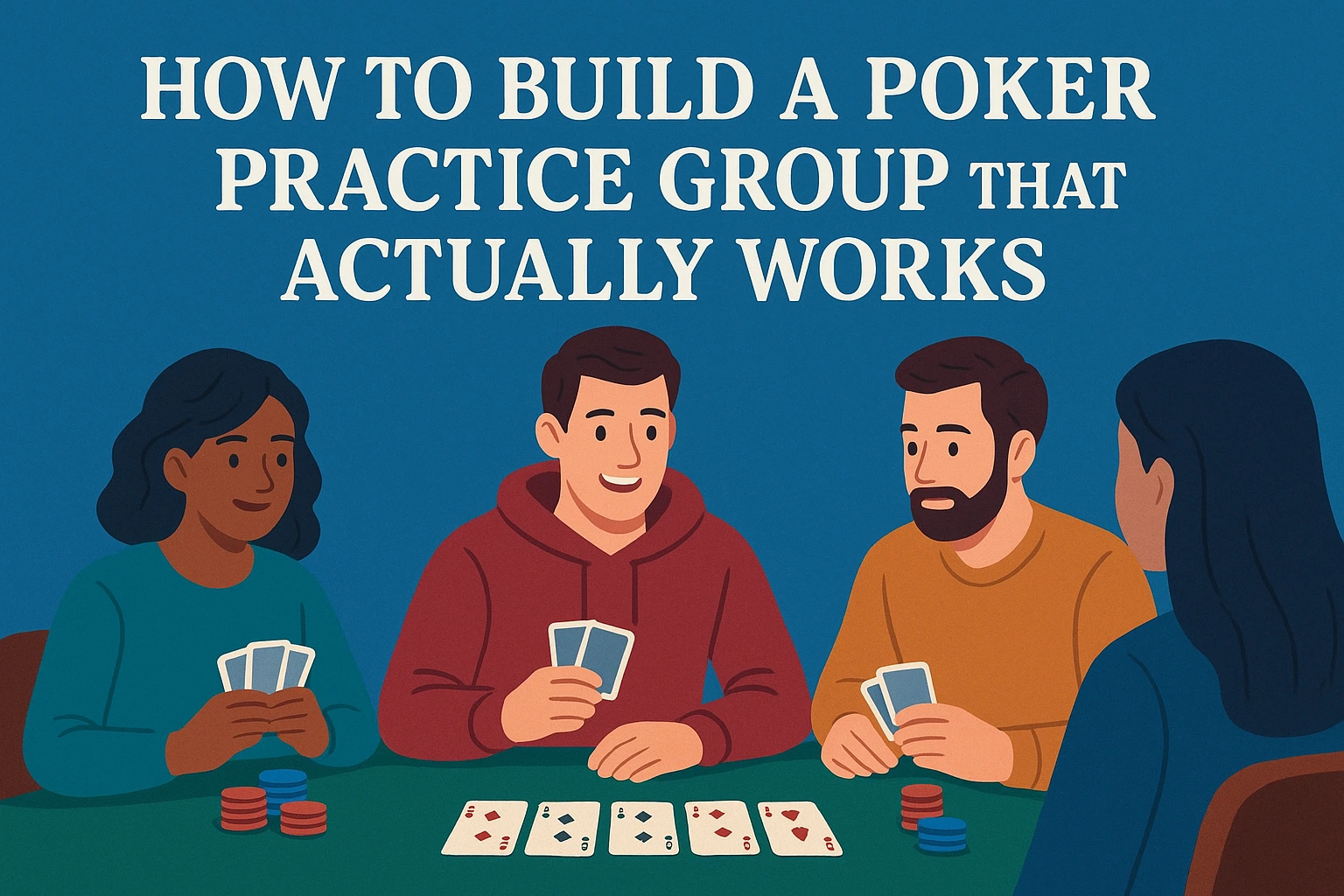
Ever wondered how to build a poker practice group that doesn’t fade away after a few sessions? The quick answer, focus on purpose, consistency, and chemistry. A well-run group can take you from confused to confident faster than solo grinding or binge-watching random YouTube tutorials. By surrounding yourself with motivated players, you’ll build sharper instincts, a stronger mindset, and a strategy that stands up under pressure.
In this in-depth guide, we’ll explore the step-by-step process to set up, manage, and grow a poker practice group that genuinely helps you win more often. You’ll learn how to use the best free tools, create productive routines, and avoid the common pitfalls that kill most groups early on. This isn’t theory, it’s built on real practices used by top players and poker communities around the world.
Why a Poker Practice Group Matters
Poker mastery is a marathon, not a sprint. A solid practice group gives you the environment to keep improving, even when motivation dips. If you’re looking for a place to start connecting with serious players, check out the Club List on BluffingMonkeys, it’s a great way to discover active poker circles and join communities that share your passion for improvement.
- Accountability: Just like a gym partner, your group keeps you showing up consistently and working toward steady improvement rather than random streaks of effort.
- Different Perspectives: Everyone sees hands differently, and when you hear another player’s thought process, it often reveals blind spots or alternative strategies you hadn’t considered.
- Shared Knowledge: You’ll learn faster when multiple brains analyze the same spots from different angles and exchange notes on theories or game flow.
- Mental Game Support: Discussing tilt, variance, and mindset openly with others strengthens emotional control and helps maintain long-term focus.
Think of it as your poker think tank, a small group of sharp minds dedicated to making each other better.
How to Build a Poker Practice Group That Actually Works
1. Choose the Right Members
A poker group is only as strong as its people. Seek players who are genuinely committed to growth and show discipline in their approach. Passion for learning matters more than raw talent.
If you’re looking to meet competitive and active players, explore some poker tournaments, it’s a great way to connect with skilled individuals who take the game seriously and might be perfect for your study group.
Look for players who are:
- Passionate about improvement, not just playing casually for fun, so that every discussion leads to tangible insights.
- Punctual and consistent with attendance, reliability builds rhythm and accountability over time.
- Respectful during discussions; no egos, no unnecessary arguments, only productive debate that helps everyone progress.
- Open to feedback and constructive criticism, since honest evaluations are what sharpen decision-making.
Start small 3 to 6 people is ideal. Too few, and you lose variety. Too many, and structure breaks down.
2. Define a Shared Mission and Rules
Without direction, even great players can waste time. Before you start, agree on a clear vision for the group that keeps everyone focused and aligned with the same goals.
Here’s what to decide early:
- Your group’s purpose: Determine whether you’ll focus on cash games, tournaments, or general skill building, so your sessions always feel relevant.
- Frequency: Weekly or biweekly sessions work best for steady growth without burning out.
- Duration: Keep sessions between 60–90 minutes, long enough for deep analysis but short enough to stay fresh and engaging.
- Platform: Choose something accessible like Zoom, Discord, or Google Meet, ensuring everyone is comfortable with the setup.
- Tone: Maintain a friendly yet structured atmosphere, serious enough for progress, but relaxed enough to enjoy the process.
Send a short agenda before every session. For example:
- Quick review of last week’s focus topic and any follow-up notes.
- Two member hand reviews with detailed reasoning and group analysis.
- Discussion of a core poker concept (ICM, bluffing frequency, etc.).
- Wrap up with key takeaways, assignments, and goals for next session.
Building a Smart Poker Practice Group Strategy
A solid poker practice group strategy keeps your sessions fresh, structured, and impactful. Here’s a tried-and-tested format that top poker study groups rely on:
- Theme of the Week: Dedicate each session to a single topic like continuation betting, defending blinds, or exploiting aggressive opponents. This helps you dive deep instead of skimming the surface.
- Hand Review Rotation: Each member shares one or two interesting hands they played recently. The group dissects every move, discussing ranges, bet sizing, and possible alternative lines.
- Homework Assignments: Pick a free training video or analysis to study before the next session. Comparing everyone’s takeaways strengthens understanding.
- Progress Check: End each session by reflecting on what each player learned and what they’ll apply before the next meeting.
This structure creates a rhythm of learning that balances theory with practical insight, the hallmark of successful poker study groups.
And if you’re looking for extra tools or strategy guides to make your sessions even more effective, Bluffing Monkeys offers valuable poker resources that can help your group stay sharp and continuously improve.
Tools and Platforms for Poker Training Online Free
You don’t need expensive solvers or paid coaching to improve. Leverage these powerful resources for poker training online free, and your group will always have something valuable to explore:
- Equilab / Flopzilla Lite: Great for studying hand ranges, board textures, and equity matchups, essential for any modern poker student.
- PokerTracker / Hand2Note (trial versions): Track your playing stats, review leaks, and identify patterns that impact your win rate.
- YouTube Channels: Channels like Upswing Poker, Jonathan Little, and Raise Your Edge post in-depth strategy content ideal for group analysis.
- Forums & Communities: Join spaces like Reddit’s r/poker, CardsChat, or TwoPlusTwo to discuss hand histories and strategies with a global audience.
- Collaboration Tools: Use Google Docs for session notes, Discord for chat and organization, and Zoom for interactive live discussions.
Sharing insights from these resources keeps your sessions dynamic and grounded in fresh, evolving strategies.
Keeping Your Poker Practice Group Free and Engaging
You don’t need to spend money to keep your group productive. What matters most is energy, interaction, and creativity.
Here are a few ways to keep engagement high:
- Mini Challenges: Create fun goals like “play 500 hands focusing only on 3-bet bluffs” to encourage practice between sessions.
- Themed Nights: Dedicate evenings to specific elements, mental game, bankroll management, or adjusting to loose opponents.
- Guest Coaches: Invite a strong player or coach for one free session to bring in fresh insights and motivation.
- Live Play Reviews: Watch one member’s screen as they play micro-stakes online. Discuss decision points live to simulate real-time thinking.
When everyone feels included and energized, learning becomes a shared adventure rather than a routine task.
Avoid These Common Mistakes
Even the most enthusiastic poker groups can lose momentum if they fall into predictable traps. Here’s what to watch out for:
- Lack of Direction: Random chats about poker don’t lead to measurable progress. Structure is essential for consistent improvement.
- Uneven Participation: Ensure everyone contributes equally, when one or two dominate, engagement drops quickly.
- Scheduling Chaos: Changing days too often leads to missed sessions and disorganization. Choose a fixed time and stick to it.
- No Accountability: Without notes, recaps, or follow-up goals, it’s easy to stagnate. Track attendance and outcomes regularly.
A shared Google Sheet or Trello board for goals, attendance, and progress summaries can keep everyone aligned and responsible.
Tracking Progress and Staying Motivated
Poker isn’t about instant results, it’s about steady, visible improvement over time. To gauge how well your group is working, keep an eye on these areas:
- Statistical Growth: Record your monthly win rate, preflop stats, and positional leaks to see measurable progress.
- Group Learning Milestones: Set achievable goals like mastering flop textures or improving c-bet frequencies, then review them monthly.
- Leak Reviews: Analyze your recurring mistakes together and brainstorm solutions to eliminate them systematically.
- Mindset Tracking: Reflect on emotional control, tilt management, and overall decision confidence.
Progress in poker isn’t just about profits, it’s about playing smarter and feeling more in control every time you sit down at the table.
FAQs
- How often should a poker practice group meet?
Weekly meetings are the sweet spot for most players. Meeting too often leads to burnout, while longer gaps make it hard to stay consistent and connected. - What if members drop out or lose interest?
Recruit replacements through Discord servers, poker communities, or even online home game groups. Keep the energy flowing by inviting players who share similar goals. - Are free poker training tools enough to improve?
Definitely! When used with structured discussion and real feedback, free resources can take you a long way before you ever need paid coaching. - How can beginners benefit from a poker practice group free?
Beginners grow faster when they analyze hands with others, understand different viewpoints, and get honest feedback on their plays. - What’s the best poker practice group strategy for steady growth?
Combine theory study with real hand reviews, focus on one improvement area per week, and keep sessions interactive and purpose-driven.
Conclusion
Building a poker practice group that actually works isn’t just about gathering players, it’s about creating a system that breeds consistency, trust, and growth. When you take time to form a like-minded team, set clear goals, and use modern online tools, your poker journey becomes less of a solo grind and more of a shared evolution.
Remember, even professional players rely on communities for accountability and insight. Whether you start a local meet-up or join a poker practice group free online, the benefits are huge sharper strategies, emotional control, and a deeper understanding of the game.
So don’t wait for perfection. Take the first step today, gather your poker circle, and build the kind of group that keeps everyone improving, motivated, and winning together. That’s how you turn poker practice into poker mastery.
